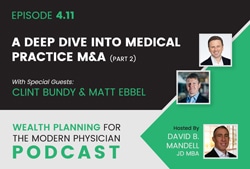In the second part of the podcast, host David Mandell continues his conversation with investment banker Clint Bundy and private equity principal Matt Ebbel, focusing on the factors that contribute to successful mergers and acquisitions (M&A) in the healthcare sector, including medical, dental, and veterinary practices. They delve into what makes a practice an attractive acquisition target, the importance of cultural and strategic alignment, and future trends in healthcare M&A.

(Video Available February 22, 2024)
Matt Ebbel emphasizes the importance of considering the “day after” a sale, where physicians might find themselves with new responsibilities and a change in their work dynamics. He stresses the need for ownership alignment, candid dialogues about success, and the importance of evaluating the financials, doctor and staff retention, and the culture of a practice. Red flags include a lack of alignment, high turnover, and compliance issues. Ebbel also touches on the importance of setting realistic expectations regarding income adjustments post-acquisition to ensure a fair and sustainable deal and the value of physicians working with a financial advisor to see how a deal impacts their personal financial goals.
Clint Bundy outlines the “three legs of the stool” approach to evaluating practices: stability, profitability, and growth, with scale as a possible fourth factor. He emphasizes that while scale is beneficial, it’s not a must-have for a practice to be considered strong. Clint also highlights the necessity of running a competitive process to ensure the best offers for a practice, stressing the importance of certainty to close alongside the financial offer.
Both guests agree on the critical role of cultural fit and strategic alignment between the acquiring and acquired entities. They advise practices to conduct thorough due diligence on potential partners, considering factors like the platform’s resources, commitment to medical quality, and the investment partner’s track record and vision for leveraging technology.
Looking ahead, both Clint and Matt express optimism for the M&A market in healthcare, despite recent macroeconomic challenges. They anticipate continued interest from private equity and possibly an increase in activity as market conditions stabilize. Ebbel specifically mentions potential public offerings by major players as a future benchmark that could spur more interest in the sector.
In summary, the podcast provides valuable insights into the complexities of healthcare M&A, offering practical advice for practices considering a sale or partnership. The discussion underscores the need for strategic planning, thorough due diligence, and alignment of values and goals to ensure successful transactions in the ever-evolving healthcare landscape.
Takeaways
Takeaway 1: Prioritizing cultural and ownership alignment in acquisition deals
In the acquisition process, medical and dental practices should prioritize cultural and ownership alignment with potential partners. Matt Ebbel emphasized the importance of having a clear understanding of what success would look like for both parties involved in the deal.
“Ownership alignment and just a candid dialogue about what’s going to success look like for you and for us is probably number one,” Ebbel stated. He also highlighted the necessity of evaluating the financials and understanding the company’s history, growth, and staff retention.
Red flags to look out for include turnover, cultural issues, and coding and compliance areas. Ebbel warned against overly aggressive financial adjustments, which might lead to discontent after the deal: “If you have someone overpay and everyone’s upset on day two, that’s not good either.”
Takeaway 2: Importance of competition and evaluating offers in physician practice management
Clint Bundy highlighted the importance of competition in the M&A market when determining the best value for physician practices. He advised that practices should consider both quantitative factors (like transaction value and structure) and intangible factors (like certainty to close).
“Bundy Group, we’re not wedded to selling to a private equity group or a private equity backed platform. But the truth is that is a big driver today of a lot of what’s going on in the M&A market for healthcare and physician practice management,” Bundy said.
He also emphasized that while the highest offer might seem the most appealing, it is not always the best choice if the buyer’s certainty to close is low.
Takeaway 3: The future of M&A in healthcare services and physician practice markets
Despite the recent slowdown in deal volumes, both Clint and Matt expressed optimism about the future of M&A in healthcare services and physician practice markets. Ebbel pointed out that interest rates and wage inflation pressure from payers are significant factors impacting the current market conditions.
“Buyers and sellers are finding themselves, again, market conditions are stabilizing, and I think it will remain as Clint said, a very active area for private equity. I think we’ll start to see a few of the bigger companies such as Aspen Dental in the dental space or NDA in the vet space, try and go public in the next one to two years, and that will set a benchmark, which the private markets will then key off of,” Matt predicted.
Clint, on the other hand, highlighted that while some segments of physician practice management are more consolidated than others, there is still plenty of room for investment in these industries. “The macroeconomic challenges right now could soften the M&A markets a little bit. It already has for the past year and could continue a little bit more into 2024, but we’re still very bullish based on what we’re seeing in our pipeline,” Clint stated.
Insights:
- Cultural alignment, platform resources, and a vision for implementing technology are crucial factors to consider when evaluating potential partners.
- Physicians should engage with a financial advisor to understand how a potential deal impacts their personal financial goals.
- The medical practice market is still robust despite a slowdown in deal volumes in 2023 due to the steep increase in interest rates.
- Wage inflation pressure from payers is motivating more practices to join larger entities to share operational burdens.
- The potential for larger companies like Aspen Dental or NDA to go public could set a benchmark for the private markets.
Links:

